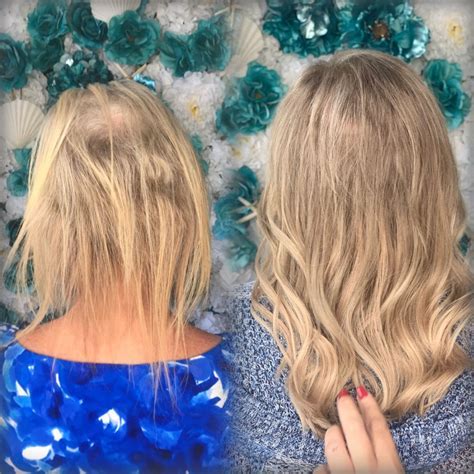Thinning hair can be a frustrating and distressing issue for many people. Whether it’s caused by genetics, age, or lifestyle factors, hair loss can significantly impact self-esteem and confidence. Fortunately, there are numerous hair weave options available that can help to restore fullness and volume to thinning hair.

Table 1: Types of Hair Weaves for Thinning Hair
| Technique | Description |
|---|---|
| Clip-ins | Convenient and easy-to-use hair extensions that attach with clips. |
| Tape-ins | Thin, adhesive-backed hair wefts that are bonded to the scalp. |
| Fusion | Hair extensions that are attached to the natural hair using heat or glue. |
| Micro-links | Hair extensions that are attached using tiny, metal beads. |
| Sew-ins | Hair extensions that are sewn directly into the natural hair. |
Table 2: Benefits of Hair Weaves for Thinning Hair
| Benefit | Details |
|---|---|
| Increased Volume | Hair weaves add instant thickness and fullness to thinning hair. |
| Length and Color Versatility | Hair weaves allow for experimentation with different lengths, colors, and textures. |
| Protective Hairstyle | Certain types of hair weaves, such as braids, can protect natural hair from breakage. |
| Customizable | Hair weaves can be tailored to match the natural hair texture, color, and density. |
Table 3: Choosing the Right Hair Weave Technique for Thinning Hair
| Factors to Consider | Recommendations |
|---|---|
| Hair Density | People with very thin hair may need to choose a less permanent method, such as clip-ins or tape-ins. |
| Scalp Sensitivity | Those with sensitive scalps should opt for hypoallergenic adhesives or gentle attachment methods. |
| Lifestyle | Tape-ins or sew-ins may be more suitable for those with active lifestyles or frequent hair manipulation. |
| Budget | Fusion and micro-links tend to be more expensive than other techniques. |
Table 4: How to Care for Hair Weaves on Thinning Hair
| Care Tips | Importance |
|---|---|
| Gentle Washing | Use a sulfate-free shampoo and avoid over-washing. |
| Conditioning | Apply a deep conditioner regularly to nourish both the natural hair and the hair weave. |
| Detangling | Use a wide-tooth comb or detangling brush to prevent tangles and breakage. |
| Avoid Heat Styling | Excessive heat can damage both the natural hair and the hair weave. |
| Regular Touch-Ups | Visit a professional stylist every 6-8 weeks for maintenance and reattachments. |
Effective Strategies for Managing Thinning Hair with Hair Weaves
- Choose a Natural-Looking Weave: Opt for hair weaves that blend seamlessly with your natural hair color and texture.
- Start with Smaller Weft Sizes: Smaller wefts will add volume without creating an unnatural or bulky appearance.
- Use Temporary Weft Styles: Clip-ins or tape-ins can be used to instantly boost volume for special occasions or while transitioning to a more permanent solution.
- Consider Protective Styles: Braids or cornrows can protect both the natural hair and the hair weave from breakage and damage.
- Focus on Scalp Health: Maintain a healthy scalp by using gentle shampoos, scalp treatments, and protective hairstyles.
Step-by-Step Approach to Applying Hair Weaves for Thinning Hair
- Prepare the Natural Hair: Wash and detangle your hair, then create small cornrows or braids.
- Insert the Weft: Place the hair weft under the cornrow or braid and secure it with thread or beads.
- Repeat: Continue adding wefts until the desired volume is achieved.
- Style: Style the hair weave to blend with your natural hair.
Pros and Cons of Hair Weaves for Thinning Hair
Pros:
- Increased Volume: Hair weaves offer an instant and dramatic increase in hair volume.
- Length and Color Options: Weaves allow you to experiment with different hair lengths, colors, and textures.
- Protective Hairstyle: Some weave techniques, such as braids, can protect the natural hair from breakage and damage.
- Versatile and Customizable: Weaves can be tailored to match the natural hair’s density, texture, and color.
Cons:
- Scalp Irritation: Certain types of adhesives and attachment methods can cause scalp irritation or allergic reactions.
- Maintenance: Hair weaves require regular maintenance and touch-ups to prevent matting, breakage, or damage.
- Cost: Permanent weave techniques, such as fusion and micro-links, can be expensive.
- Temporary Solutions: Some weave techniques, such as clip-ins and tape-ins, are not permanent and require regular reattachment.
Innovative Applications of Hair Weaves for Thinning Hair
- Stem Cell Weaves: Weaves made with stem cells have the potential to regenerate natural hair follicles and promote hair growth.
- Biomimetic Weaves: New weave technologies mimic the structure and function of natural hair, providing a more realistic and comfortable option.
- 3D-Printed Weaves: 3D printing can create custom-made weaves that perfectly match the individual’s hair texture and color.
- Integrated Weaves: Weaves that incorporate sensors or LEDs can monitor scalp health and provide hair care treatments.
